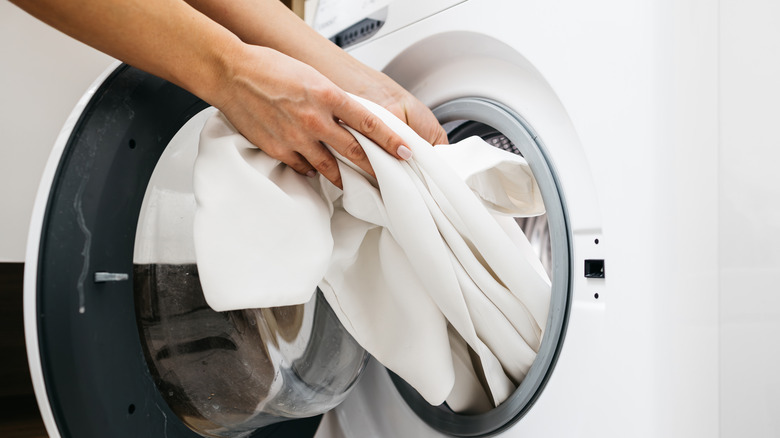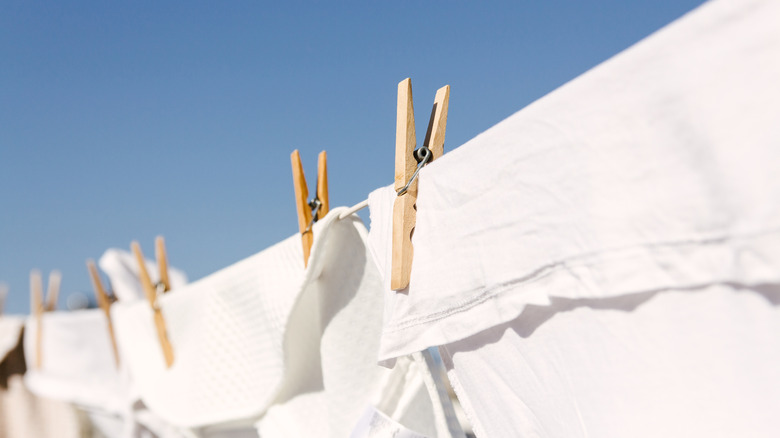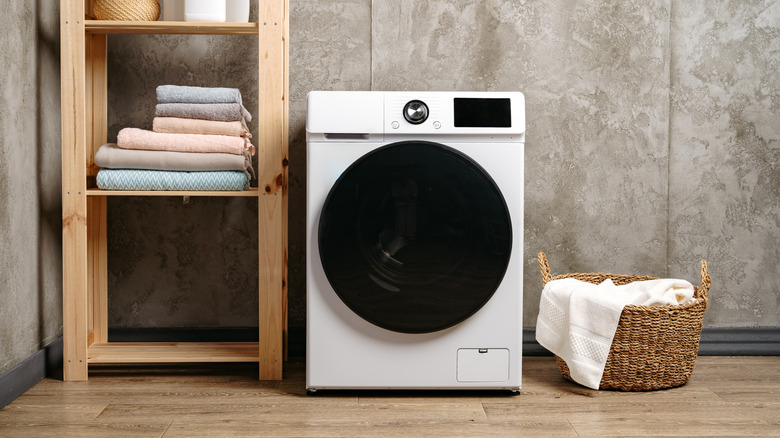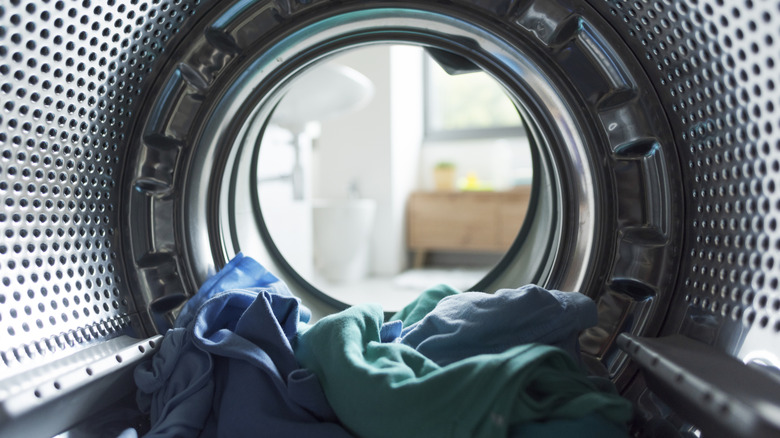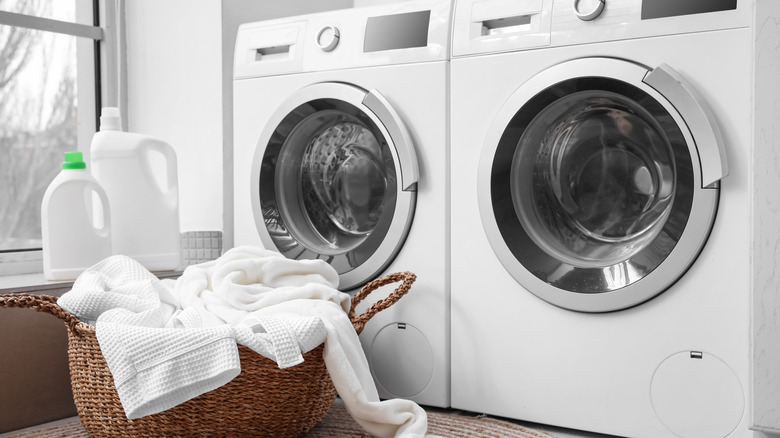12 Reasons Front Loader Washing Machines Are Considered Better (And If We Agree)
So, you're in the market for a new washing machine — or maybe you just want to prove once and for all that the model you've already got is superior. After all, the top-loading washer versus front-loading washer debate has been raging for decades. Most people have a machine they'd vigorously defend (and let's face it, it's probably the one they grew up using). But is the top-loading machine or the front-loading machine actually the better option?
Most experts have long agreed that front-loading machines are generally better at cleaning and stain removal than top-loading washers — and front-loading washers are way more eco-friendly, too. But there are even more reasons why many people consider front-loading washers to be better than top-loading machines, and we want to figure out whether those reasons are actually true. From the water usage of front-loading washing machines to whether or not they're easier to load and unload, these are the most common reasons you'll find in defense of front-loading washers (and which reasons can really be backed up). Whichever one you decide to stick with in the end, however, just make sure you know how to clean your washing machine properly after you use it.
Front-loading washers save water
Top-loading washers work with an agitator or impeller — your clothes are powerfully swished around in a top-loading washing machine, which is how they're cleaned. But in order for this to work properly, your clothes need to be completely soaked in water. This means that every top-loading machine is going to need enough water to submerge your clothes multiple times throughout the washing process.
Front-loading machines, on the other hand, conserve more water than top-loading machines. That's because they tumble your clothes around, which means they can lightly douse your clothes with water and then tumble them clean rather than keeping them submerged the entire time. On average, your front-loading washing machine probably only uses between 16 and 24 gallons of water per cycle. But that top-loading washing machine? It can use up to 40 gallons in just a single cycle — looking at that average over the span of a year, a top-loading washing machine could use over 16,000 gallons of water every year. Not only is this much less sustainable, but it also means that you can say goodbye to your low water bill.
Front-loading washers conserve energy
A front-loading washing machine can save a lot of energy by not needing to heat as much hot water as a top-loading machine. In addition to that, the tumbling cycle in a front-loading machine is generally much gentler than a top-loading machine, which means that it doesn't require as much energy per cycle to work.
Another major benefit of front-loading washers is that they continue to tumble your clothes with their fast spin cycles even after they're done rinsing. This quick tumbling helps to dry your clothes before they come out of the washer, so they can spend less time (and use less energy) in the dryer. Additionally, your clothes are likely to never come out dripping wet from a front-loading washer like they would a top-loading washer (trust us, we've been there). This means that you can hang your damp clothes as soon as they come out of your front-loading washer, circumventing the need for extra energy. The average front-loading washer can use 30% to 50% less energy than a top-loading washer can. That's a big benefit for the environment and for your electric bill, too.
Front-loading washers are better for your clothes
A top-loading washer will often come with an agitator: that mechanism in the center of the washing machine that spins your clothes around. Believe it or not, this agitator can be quite rough on your clothes. Not only does the vigorous spinning and back-and-forth motion of the agitator cause your clothes to rub and tangle, but continuous use can wear your clothes out faster over time than they would with a front-loading washer — just another laundry mistake that's ruining your clothes. You might also notice other agitator problems — like how your clothes with straps get wound around the agitator, or how you struggle to extract your bed sheets from being caught up around the agitator pole.
A front-loading washer uses a tumbling action to clean your clothes. Because there's no agitator pole spinning them around, your clothes and linens tend to wear (and tangle) less. Being cleaned in a tumbler is much gentler on your clothes than being agitated. This means that, if you switch from a top-loading washer to a front-loading washer, you may notice your clothes lasting longer. This is especially nice for delicate materials, like wool or cashmere, for example; the gentler cycle means that you can safely wash them with less stress. On the other hand, if you switch over to a top-loader — you might suddenly notice extra wear or cumulative damage on items that washed just fine in your previous machine (we've also been here, and yes, unexpected damage can be a thing).
Front-loading machines save hot water, too
Front-loading washers use less water than top-loading washers, which naturally means that you spend less money on hot water over time. This is especially useful if your home runs on a tank water heater. A front-loading washer means that you can actually run a hot cycle of laundry without worrying about running out of water.
The average hot water tank can hold about 40 to 50 gallons of hot water at a time. The average front-loading washing machine will only take up to 24 gallons of this hot water — and some machines will use as little as seven gallons per load. Top-loading washing machines use an average of 40 gallons of water per load. That's your entire hot water tank, gone in an instant. So much for doing the dishes or taking a bath if you've got laundry going. At least energy-efficient top-loading models will use less water per cycle, so your mileage may vary depending on the model you choose.
By using less hot water, front-loading washers are also using less energy than top-loading washers. But despite this energy efficiency, they're even better than top-loading machines at using hot water to remove stains and sanitize clothes. You'll notice that some front-loading models will even have dedicated cycles to sanitize your clothes so that they're germ-free. Some will also offer steaming options to help in place of extra hot water.
Front-loading washers can be easier to load
For some people, front-loading washers can be easier to load, but this does depend on your height and your washer's relative ease of access. With some front-load washers, the doors will be fairly accessible for people of short to medium height; when they open the door of the washer and stick their clothes inside, they won't have to bend over much (if at all) to do so.
If you're on the taller side, you might actually prefer a top-loading washer in terms of comfort. It will still require you to bend down toward the machine to pull your clothes out once they're finished washing, but it is a lot easier to drop your clothes into the washer without needing to bend over. For those who are shorter, however, reaching down and into a top-loading washer to grab the lone shirt stuck to the bottom of the drum can be tricky.
There is no singular answer to whether a top-loading washer or front-loading washer is easier to load, so we can't strictly agree with this argument. Depending on how you position your washer in your laundry room, the height of your washer, how you do your laundry, and how tall you are, your comfort with a front-loading machine versus a top-loading machine is entirely variable. But it might be nice to know that for both a front-loading and top-loading machine, you can get pedestals that will raise the machine up higher if you need to make it easier to reach.
Front-load washers require less drying time
The spin cycle on a front-loading washer is quite fast, and it also uses less water. Your clothes receive water-free tumble spinning action toward the end of their washing cycle, which helps to carefully ring the water out of them. With many front-load washers, you can adjust this to give your clothes extra time in the spin cycle.
Whether or not you're planning on machine-drying your clothes afterward, this spin cycle is extremely important. We tend to see that clothes can come out damper with a top-loading machine than they do a front-loading machine. Also, if there is an issue with your machine (like an unbalanced drum), when you pull your clothes out of a top-loading washer, they might still be dripping wet.
With a front-loading washer, this is almost never the case. When you pull your clothes out, they should always be relatively dry to the touch — more damp than dripping wet. If you dry your clothes after you wash them, you can save even more time and energy, because they'll take a much shorter amount of time to dry completely. But even if you plan on hanging your clothes up to dry as soon as they're out of the wash, it's still nice that they take less time to dry than they would otherwise ... not to mention the fact that you don't have to deal with water dripping everywhere while you hang your clothes.
Front-loading washers are quieter
Whether or not a front-loading washer is quieter than a top-loading washer depends on the exact model. Front-loading machines are generally quieter than top-loaders — that's again because of the tumbling cycle versus the agitator cycle. However, you can certainly find ultra-quiet models of both front-loading washers and top-loading washers.
Though top-loading washers have a reputation for being louder than front-loading washers, front-loading machines can sometimes vibrate more than top-loading washers, so their vibrations can be heard in connecting rooms of the home. Then again, you can always purchase a model that's low-vibration, so you can't hear it unless you're in the same room. In the end, especially with all the different models available, it's kind of a toss-up as to which machine is truly quieter. If you're intent on buying the quietest laundry machine possible, then you should probably try to test out your favorite models before you actually purchase either.
Front-loading washers generally clean better
Because front-loading machines are known for being gentle on your clothes, you may think they don't clean as well as a top-loading machine. But that's generally not true. An agitator, while rough, is not as effective at cleaning as the tumbling cycle that front-loading machines use. When your clothes are in your front-loading washing machine, they are literally being lifted up while tumbling around; this allows for a more thorough cleaning action. Because of this, the cleaning power of a front-loader is more effective than a top-loading washer, even for bulky items.
In addition, you may find that your front-loading washer has more cycle options than your top-loading washer. If that's the case, your clothes might come out cleaner because you have access to more specific, efficient laundry cycles. This benefit of front-loading washers is much more variable than the agitator-versus-tumbler debate, however — depending on the model of front- and top-loading washer you choose, your available cleaning cycles may look similar.
Front-loading washers are better with stain removal
Believe it or not, front-loading washers are actually much more effective at removing stains than top-loading washers. It's for the same reason that they're better at cleaning clothes in general: The tumbling action from your front-loading washer helps to target and lift stains more thoroughly than a top-loading washer is able to.
With an agitator, not all of your clothes might be as thoroughly cleaned, which means they can make it through a cycle without enjoying complete stain removal. For a front-loading washer, however, the opposite is true. All of your clothes will be thoroughly cleaned from the friction and lifting action inside the front-loading machine.
If you're considering the difference between a front- and top-loading machine when it comes to serious stain removal, let's consider the pre-soak. Many people prefer to pre-soak their clothes before washing them to help remove stains and buildup. In this case, both a top-loading and front-loading washer could be the right pick for you. With a top-loading washer, you can pre-treat your clothes by simply filling the machine and leaving the lid open. With a front-loading machine, however, you're likely to find an optional soaking cycle that allows you to set your clothes to soak for a certain amount of time before the cycle begins.
Front-loading machines generally have more cycle types
Generally speaking — again, this depends greatly on the machine model you choose — front-loading washers have more cycle types than top-loading washers. While top-loading washers are advancing in terms of technology, front-loading washers tend to have more capabilities. Front-loading machines also tend to have more models with extra cycles built in, whereas top-loading machines offer these options as special features that cost more money ... however, front-loading machines are generally more expensive in the first place, so you've got a lot to consider.
The cycles that your machine offers will depend on what model you buy. A basic top-loading washer will likely come with less than 10 different cycles for different types of clothes. A front-loading washer, however, might offer add-ons like a steam cycle, a permanent press, or a self-cleaning cycle. These are handy if you want your washing machine to have more features; for a front-loading washer, it's easy to find machines with these cycle types included. Top-loading machines tend to have fewer model options to pick from if you really want your machine to include these cycles.
Front-loading machines are stackable
Those on the team of front-load washers might be quick to point out that front-loading machines are stackable, while top-loading machines are not. It's true that most front-loading models are easy to stack, because the doors are on the sides of both machines. Not all top-loading washers can be stacked, but it's untrue to say that none of them can be; you just need to find the right model.
With most stackable top-loading washers, the washing machine will go on the bottom, with the dryer on top. The dryer will have a cutout at the bottom that allows you to easily open the lid of the top-loading washer. These models are usually sold as a set, so they're harder to come by than front-loading models you can simply stack on top of one another. But it's not impossible for a top-loading washer to stack; it just depends on the model you buy.
On the flip side of things, not all front-loading washer models can be stacked, either. There may be necessary components on the top of the washer that can't be blocked by a dryer. These are a pretty rare type of front-loading washer, generally speaking. But it's just another reason why you really have to look at the exact model you're purchasing when it comes to stacking your washing machine and dryer.
It's easier to transfer clothes to your dryer with a front-loading machine
Some people argue that front-loading washing machines make it easier to move your clothes into the dryer. They certainly do give that impression, because front-loading washers usually have reversible doors — as in, you can switch the side that the hinges are on, so there's no door getting in your way when you transfer your clothes from the washer to the dryer.
However, we'd argue that both a top-loading machine and front-loading machine are of equal simplicity when it comes to transferring clothes. The biggest difference you'll see here is how you arrange your machines, and also how comfortable it is for you to reach into your machines and transfer your clothes. It's less about the model and more about what your setup looks like. Besides, while it's always nice to find front-loading machines that have flexible doors, with a top-loading washer, you'll never have to change the direction of the door.


